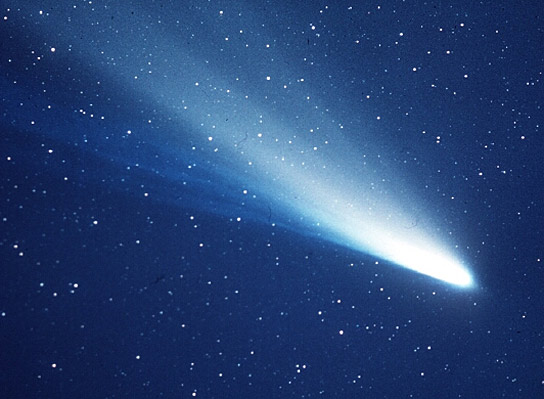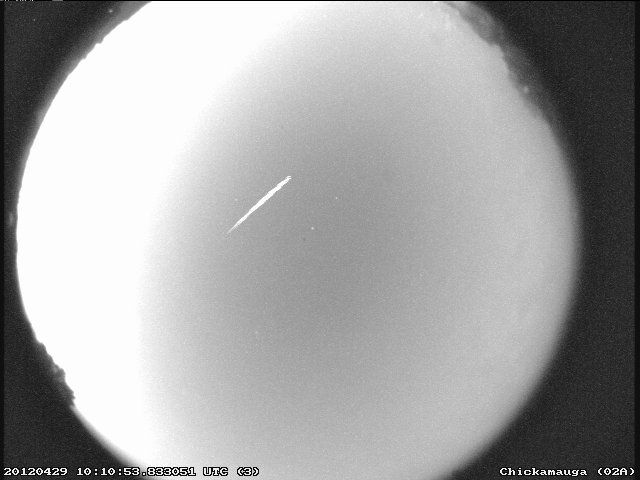Meteor Shower of Halley's Comet Pieces Peaks Sunday: Watch It Live

A meteor shower made from the dusty leftovers of the famed Halley's Comet will be at its best on Sunday (May 5) and NASA doesn't want you to miss it.
The annual Eta Aquarid meteor shower will peak Sunday night and NASA scientists will provide live views of the celestial fireworks display in a webcast from the agency's Marshall Space Flight Center in Huntsville, Ala. The webcast and chat will run from 11 p.m. to 3 a.m. EDT (0300 to 0700 May 6 GMT), NASA officials said.
You can watch the Eta Aquarid webcast live on SPACE.com, courtesy of NASA.
"This year the peak will occur on the night of May 5 about 9 p.m. EDT with meteor rates of about 30-40 meteors per hour near peak. Eta rates will also be good on the evening of May 4," NASA officials said in a statement. "The Etas contain quite a few fireballs. Ideal viewing conditions are clear skies away from city lights, especially just before dawn." [Halley's Comet's Yearly Meteor Attack on Earth (Video)]

Astronomer Bill Cooke, a veteran meteor expert and head of NASA's Meteoroid Environment Office at Marshall Space Flight Center, will answer questions in the online chat during the Eta Aquarid meteor shower webcast. Live camera views of the display will be provided by a light-activated camera mounted outside the center that automatically turns out as evening falls each night.
The Eta Aquarid meteor shower is one of two "shooting stars" displays created by dusty debris from Halley's Comet, which orbits the sun once every 76 years. The comet was last visible from Earth in 1986, but it has left trails of dust across the solar system that, as the Earth passes through them, create the Eta Aquarid meteor shower in early May and the Orionid meteor shower in mid-October.
The Eta Aquarid display is named after the constellation Aquarius because it appears to radiate out from nearby that star pattern. It is known for creating bright fireballs that can dazzle observers. But stargazers should not stare directly at Aquarius while trying to see the meteor shower.
Get the Space.com Newsletter
Breaking space news, the latest updates on rocket launches, skywatching events and more!
The best way to maximize your chances of seeing a meteor is to find an observing spot far from city lights and look straight up at the night sky, NASA officials said. A blanket, lawn chair or sleeping bag can make things extra comfortable, they added.
Also be sure to allow about 30 minutes for your eyes to adjust to the darkness.
While the Eta Aquarid and Orionid meteor shower give stargazers a chance to see bits Halley's Comet each year, observers will have to wait a while before seeing the actual comet in the night sky. The next time Halley's Comet will swing near Earth will be in 2061.
Editor's note: If you have an amazing picture of any night sky view that you'd like to share for a possible story or image gallery, send photos, comments and your name and location to managing editor Tariq Malik at spacephotos@space.com.
You can participate in the live NASA meteor shower chat here: http://www.nasa.gov/connect/chat/aquarids_2013.html
Email Tariq Malik at tmalik@space.com or follow him @tariqjmalik and Google+. Follow us @Spacedotcom, Facebook and Google+. Original article on SPACE.com.
Join our Space Forums to keep talking space on the latest missions, night sky and more! And if you have a news tip, correction or comment, let us know at: community@space.com.

Tariq is the Editor-in-Chief of Space.com and joined the team in 2001, first as an intern and staff writer, and later as an editor. He covers human spaceflight, exploration and space science, as well as skywatching and entertainment. He became Space.com's Managing Editor in 2009 and Editor-in-Chief in 2019. Before joining Space.com, Tariq was a staff reporter for The Los Angeles Times covering education and city beats in La Habra, Fullerton and Huntington Beach. In October 2022, Tariq received the Harry Kolcum Award for excellence in space reporting from the National Space Club Florida Committee. He is also an Eagle Scout (yes, he has the Space Exploration merit badge) and went to Space Camp four times as a kid and a fifth time as an adult. He has journalism degrees from the University of Southern California and New York University. You can find Tariq at Space.com and as the co-host to the This Week In Space podcast with space historian Rod Pyle on the TWiT network. To see his latest project, you can follow Tariq on Twitter @tariqjmalik.









